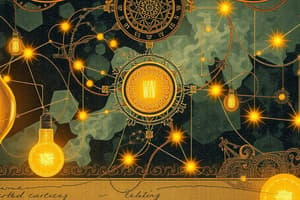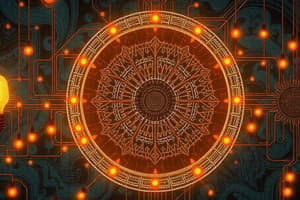Podcast
Questions and Answers
Which of the following correctly describes Ohm's Law?
Which of the following correctly describes Ohm's Law?
- Resistance increases with voltage.
- Current is directly proportional to voltage. (correct)
- Current is independent of resistance.
- Voltage is inversely proportional to current.
In a series circuit, the total current is different at various points.
In a series circuit, the total current is different at various points.
False (B)
What is the unit of measurement for voltage?
What is the unit of measurement for voltage?
Volts
The formula for electrical power can be represented as P = ______.
The formula for electrical power can be represented as P = ______.
Match the following circuit components with their functions:
Match the following circuit components with their functions:
What happens to the total resistance in a parallel circuit?
What happens to the total resistance in a parallel circuit?
Electrical energy is transferred and converted into useful forms of energy.
Electrical energy is transferred and converted into useful forms of energy.
What is the formula used to calculate electrical energy transferred?
What is the formula used to calculate electrical energy transferred?
Flashcards
What is current?
What is current?
The flow of electric charge. Measured in Amperes (A).
What is voltage?
What is voltage?
The potential difference between two points in a circuit. Measured in Volts (V). It pushes the current.
What is resistance?
What is resistance?
A measure of how difficult it is for current to flow. Measured in Ohms (Ω).
What is Ohm's Law?
What is Ohm's Law?
Signup and view all the flashcards
What is a series circuit?
What is a series circuit?
Signup and view all the flashcards
What is a parallel circuit?
What is a parallel circuit?
Signup and view all the flashcards
What is electrical power?
What is electrical power?
Signup and view all the flashcards
What is energy transfer in a circuit?
What is energy transfer in a circuit?
Signup and view all the flashcards
Study Notes
Current, Voltage and Resistance
- Current (I) is the flow of electric charge, measured in Amperes (A).
- Voltage (V) is the potential difference between two points in a circuit, measured in Volts (V). It drives the current.
- Resistance (R) is a measure of how difficult it is for current to flow, measured in Ohms (Ω).
Ohm's Law
- Ohm's Law states that the current through a conductor is directly proportional to the voltage across it.
- This is expressed mathematically as V = IR.
Series Circuits
- Components are connected end-to-end in a single loop.
- Total resistance in a series circuit is the sum of the individual resistances.
- Total current is the same at all points in a series circuit.
- Voltage is divided among the components, with higher resistance components having greater voltage drops.
Parallel Circuits
- Components are connected across each other, offering multiple current paths.
- Total resistance in a parallel circuit is less than the resistance of any single branch.
- Current is shared among branches, and the sum of the currents in each branch equals the total current from the source.
- Voltage across each component in a parallel circuit is the same.
Electrical Power
- Electrical power is the rate at which electrical energy is converted into other energy forms, measured in Watts (W).
- The formula for power is P = IV (Power = Current x Voltage).
- Power can also be calculated as P = I²R = V²/R (Power = Current squared x Resistance = Voltage squared / Resistance).
Energy Transfer
- Electrical energy is transferred from the power source to circuit components, transforming into various forms (e.g., light, heat).
- The formula for electrical energy transferred is E = Pt (Energy = Power x Time).
Circuit diagrams
- Symbols represent circuit components.
- Key symbols include:
- Battery
- Resistor
- Lamp
- Fuse
- Switch
- Ammeter
- Voltmeter
- Diagrams illustrate component connections.
Safety in Electrical Circuits
- Fuses and circuit breakers protect circuits from excessive current.
- Fuses melt at a specific current level, while circuit breakers interrupt the circuit.
- Wiring needs proper insulation.
- Avoid touching exposed wires.
- Handle components with care.
- Prevent circuit overload.
Energy Efficiency
- Energy efficiency in appliances relates useful energy output to total energy input.
- Higher efficiency (low energy) devices produce more useful energy and less waste.
- Percentage efficiency is calculated as (useful energy output / total energy input) * 100.
Studying That Suits You
Use AI to generate personalized quizzes and flashcards to suit your learning preferences.
Description
Test your knowledge on the fundamental concepts of electricity, including current, voltage, and resistance. This quiz also covers essential principles like Ohm's Law and the differences between series and parallel circuits. Perfect for students seeking to reinforce their understanding of electrical circuits.




